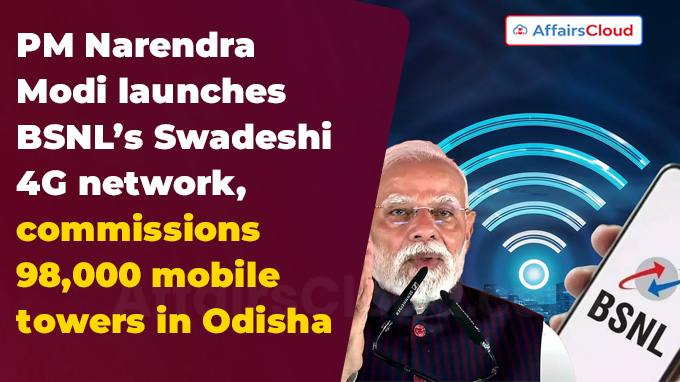In September 2025, Prime Minister (PM) Narendra Modi inaugurated Bharat Sanchar Nigam Limited (BSNL)’s ‘Swadeshi’ 4G (4th Generation) Network on the occasion of 25th Silver Jubilee establishment of BSNL in Jharsuguda, Odisha.
- Following this launch, India now enters into a league of nations such as Denmark, Sweden, South Korea, and China that develops homegrown telecom equipment.
- BSNL was established in September 15, 2000 in New Delhi, Delhi
Exam Hints:
- What? Launch of BSNL’s indigenous 4G network stack
- Launched by: PM Narendra Modi
- Where? Jharsuguda, Odisha
- Total Towers Commissioned: 97,500 including 4G sites
- Development Cost: Rs 37,000 crore
- Technology Partners: Tejas Network (RAN), C-DoT (Core-network) TCS (Integration) and BSNL (Deployment)
About BSNL’s Indigenous 4G Stack:
Technology Partners: The network features Radio Access Network (RAN) provided by Tejas Network, Core-network developed by Centre for Development of Telematics (C-DoT) under the Department of Telecommunications, Ministry of Communications (MoC), and Systems Integration was done by Tata Consultancy Services (TCS).
- While, BSNL is entrusted with the responsibility for deployment of indigenous 4G network across India.
Design Approach: The network is fully-software driven, cloud-based architecture, which ensures seamless transition to 5G and is in line with Bharat 6G Vision 2030.
Commissioning of 4G Mobile Towers:
97,500 Mobile 4G Towers: During the event, PM also commissioned over 97,500 mobile 4G towers constructed at a cost of around Rs 37,000 crore with indigenous technology.
- These 4G mobile towers also include 92,600 4G technology sites of the telecom service provider. BSNL’s goal is to reach 100,000 towers by 2026 while continuing to build a sustainable, future ready digital Infrastructure.
Coverage: These newly commissioned towers are spread across 8 states: Odisha, Andhra Pradesh (AP), Uttar Pradesh (UP), Maharashtra, Rajasthan, Assam, Gujarat, and Bihar.
Significance: More than 18,900 towers funded under the Digital Bharat Nidhi (DBN) are expected to connect over 26,700 unserved villages, including 2,472 of Odisha, in remote and border areas of the country.
- As per the Government of India (GoI), this will serve more than 20 lakh new subscribers.
Powered by Solar Energy: These new 4G mobile towers are powered by solar energy, thus, making them India’s largest cluster of green telecom sites and marking a major step forward in sustainable infrastructure.
Launch of 100% 4G Saturation Network: PM also launched India’s100% 4G saturation network through DBN. Under this new saturation network, 29,000 to 30,000 villages are connected in a mission-mode project.
About 4G:
Definition: 4G is the acronym for 4th-Generation Wireless, supersedes 3G and is the predecessor of 5G. It enables wireless broadband which allows users to get internet connectivity without the need for a fixed, wired connection from an Internet Service Provider (ISP).
Features: 4G uses technologies such as Long-Term Evolution (LTE), Multiple Input Multiple Output (MIMO), and Orthogonal Frequency Division Multiplexing (OFDM) for enhanced bandwidth, network efficiency, and reduced congestion.
Expansion of 5G in India:
Launched in: 5G (5th Generation) services was 1st launched on October 01, 2022. Within the 8 months of launch, 2 lakh sites including 700 districts have been installed.
Presence of 5G in India: Currently, 5G network has been roll out in all 28 states and 8 Union Territories (UTs) of the country, becoming the world’s fastest 5G rollouts.
- As of June 30 2025, 4.86 lakh 5G Base Transceiver Stations (BTSs) have been installed by Telecom Service Providers (TSPs) nationwide.
Stepping Stone to 6G:
Bharat 6G Vision Document: In March 2023, the GoI released its ‘Bharat 6G Vision’ document, which aims to position India as frontline contributor in design, development, and deployment of 6G technology by 2030.
- This vision document is based on principles of affordability, sustainability, and ubiquity.
Bharat 6G Alliance: The DoT under MoC, has facilitated the establishment of ‘Bharat 6G Alliance’, an alliance of local industry, academia, national research institutions, and standards organisation to develop a roadmap for Bharat 6G Vision.
Other Key Initiatives under by GoI for 6G Rollout:
Setting-up of 100 5G Labs: So far, the GoI had established 100 5G labs at academic institutions for capacity building and a 6G-ready academic and start-up ecosystem.
- As of July 31 2025, the GoI approved104 projects worth Rs 275.88 crore under TTDF scheme.
Technology Innovation Hub (TIH): Under National Mission on Interdisciplinary Cyber-Physical Systems (NM-ICPS), the GoI had established Technology Innovation Hub (TIH) at International Institute of Information Technology (IIIT) Bangalore in Bengaluru, Karnataka.
Global Scenario:
GSMA Mobile Internet Connectivity: According to the State of Mobile Internet Connectivity Report 2025, the majority of network investment continues to be in deployment of 5G technology, which has now reached over half of the population in the world (54% or 4.4 billion people worldwide), with over 700 million additional people covered in 2024.
- Also, monthly 5G traffic in India increased 3 times during 2024 and now accounts for 36% of India’s total mobile traffic, compared to 15% in 2023.
Key Statistics by ITU: As per the statistics of the International Telecommunication Union (ITU), nearly 5.5 billion people (68% of world’s population) are using the internet in 2024.
- 5G expanding unevenly: At global level, 5G network coverage reaches 51%; while its coverage reaches 84% in High Income Countries (HICs) as against 4% in Low-Income Countries (LICs).
- Improvement in Gender Parity: As per ITU estimates, 70% of men and 65% of women use the internet in 2024.
- Youth are more connected: 79% of people aged 15-24 are using internet, 13 points higher than people of other age group.
About Bharat Sanchar Nigam Limited (BSNL):
Chairman and Managing Director (CMD)- A. Robert Jerard Ravi
Headquarters- New Delhi, Delhi
Established- 2000




